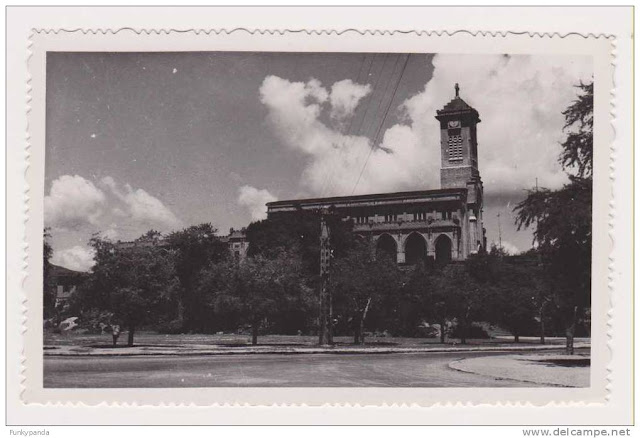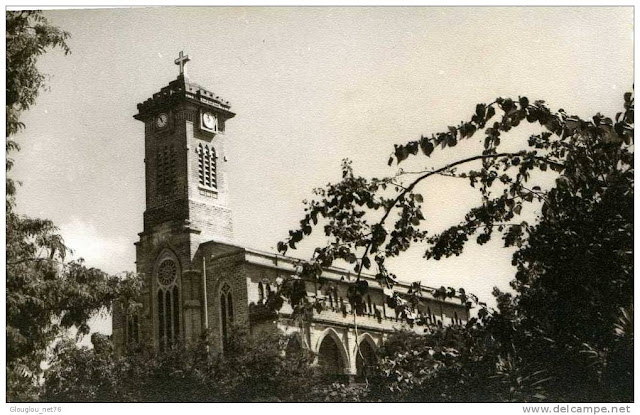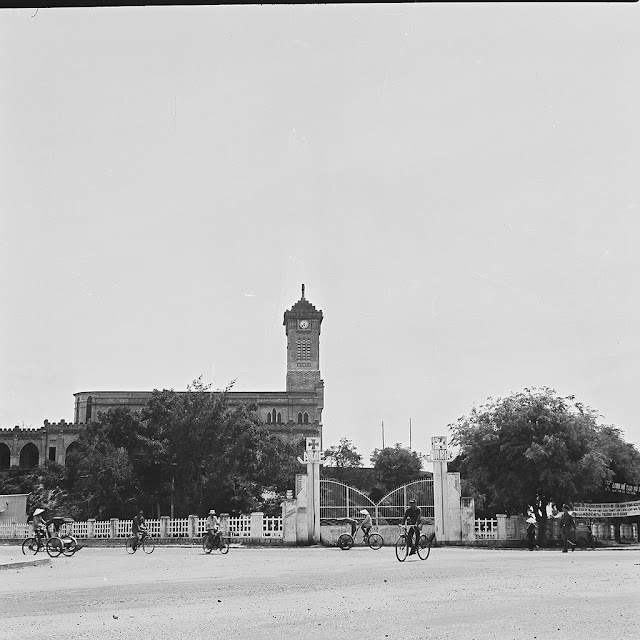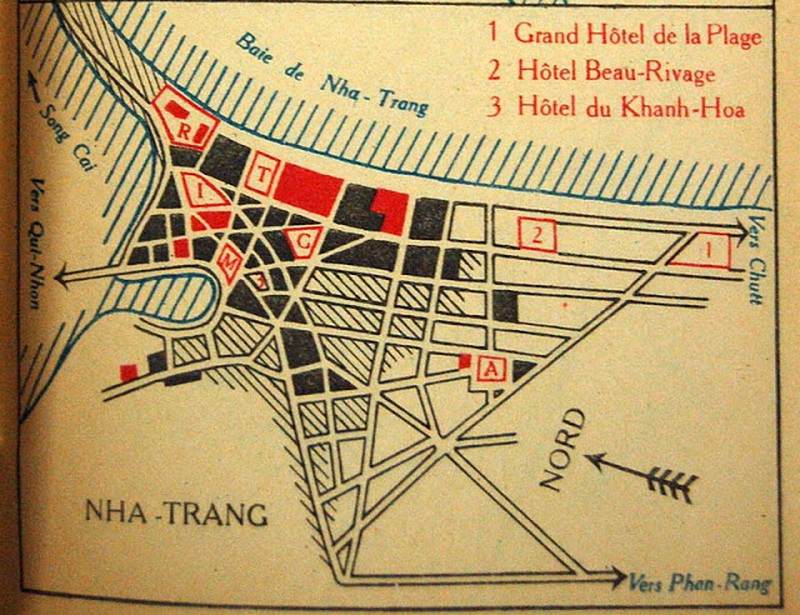Nha Trang City once upon a time!
Whether you have had the opportunity to admire many landscapes on earth or visit the bays of Vietnam, you will not cease to be amazed by the wildness of the bays of Vietnam. The bay is in the top 10 of Vietnam to honor the natural, scenic and ecological heritages of the bay
Old Nha Trang City!
During the French colonial period, Nha Trang was considered the provincial capital (the chef-lieu) of Khanh Hoa province. The specialized agencies of the colonial government such as the Embassy, the Guardian, the Chamber of Commerce, and the Post Office ... are located in Nha Trang. However, the Southern dynasties such as the Tuan Vu Palace, the Homicide (consider the administration, the judiciary), and the Military (consider the security and order) are still stationed at Thanh Dien Khanh (10km west of Nha Trang. Male).
History of Nha Trang City From 1653 to the middle of the nineteenth century, Nha Trang was still a wild and wild land of Ha Bac, Vinh Xuong district, Dien Khanh. Just over the first two decades of the twentieth century, the face of Nha Trang changed rapidly. With the Decree dated August 30, 1924, of Governor-General of Indochina, Nha Trang became a town (center Urbain). Nha Trang town was formed from the ancient villages: Xuong Huan, Phuong Cau, Van Thanh, Phuong Sai, and Phuoc Hai.
Nha Trang City Through Periods
During the French colonial period, Nha Trang was considered the provincial capital (the chef lieu) of Khanh Hoa province. The specialized agencies of the colonial government such as the Embassy, the Guardian, the Chamber of Commerce, the Post Office ... are located in Nha Trang. However, the Southern dynasties such as the Tuan Vu Palace, the Homicide (consider the administration, the judiciary), and the Military (consider the security and order) are still stationed at Thanh Dien Khanh (10km west of Nha Trang. Male).
By the Decree of 7 May 1937 of Governor-General of Indochina, Nha Trang was upgraded to a town (wage) [3]. At the time of establishment, Nha Trang town had 5 wards: Xuong Huan was the first ward, Phuong Cau was the second ward, Van Thanh was the third ward, Phuong Sai was the fourth ward, and Phuoc Hai was the fifth ward.
On January 27, 1958, the Ngo Dinh Diem government issued Decree 18-BNV to abolish the statute of the town, dividing Nha Trang into two communes: Nha Trang Dong and Nha Trang Tay in the Vinh Xuong district.
On October 22, 1970, Decree No. 132-SL / NV of the Saigon government took two communes of Nha Trang Dong, Nha Trang Tay and communes of Vinh Hai, Vinh Phuoc, Vinh Truong, Vinh Nguyen, and Phuoc Hai hamlets ( Vinh Thai commune), Vinh Diem Ha (Vinh Hiep commune), Ngoc Thao, Ngoc Hoi, Lu Cam (Vinh Ngoc commune) in Vinh Xuong district with the islands of Hon Lon, Hon Mot, Hon Mun, Hon Mieu, Hon Tam re to establish Nha Trang town, the provincial capital of Khanh Hoa province. Nha Trang town is divided into 2 districts: District 1 and District 2. District 1 includes communes Nha Trang Dong, Vinh Hai, Vinh Phuoc, Ngoc Thao, Ngoc Hoi, and Lu Cam hamlets of Vinh Ngoc commune, Vinh Diem Ha hamlet. Vinh Hiep commune; District 2 includes the communes of Nha Trang Tay, Vinh Truong, and Vinh Nguyen (including Hon Tre, Hon Mot, Hon Mun, Hon Tam), Phuoc Hai hamlet of Vinh Thai commune.
Following that, Decree No. 357-ĐUHC / NC / ND dated June 5, 1971, divided Nha Trang town into 11 quarters: District 1 has quarters of Vinh Hai, Vinh Phuoc, Ngoc Hiep, Van Thanh, Duy Tan; District 2 has quarters of Vinh Nguyen, Vinh Truong, Phuong Sai, Tan Phuoc, Tan Lap, and Phuoc Hai. To Decree No. 553-BNV / HCĐP / NV of August 22, 1972, changing the towns into wards. Decree No. 444-BNV / HCĐP / 26.X dated September 3, 1974, merged Hon Mot, Hon Cau, Hon Dam, Hon Chop Vung, and Hon Do into Vinh Hai ward (district 1) and Hon Ngoc into ward Vinh Nguyen (District 2) Nha Trang town.
On April 2, 1975, Nha Trang - Khanh Hoa was completely liberated. On April 6, 1975, the Khanh Hoa Military Regulatory Committee divided Nha Trang into three administrative units: District 1, District 2, and Vinh Xuong District.
September 1975, merging two districts: District 1 and District 2 into Nha Trang town.
On March 30, 1977, according to Decision No. 391-CP / QD of the Government Council of the Socialist Republic of Vietnam, Nha Trang town was upgraded to a provincial city and the capital of Phu province. Khanh (including two provinces of Phu Yen and Khanh Hoa today). The 7 communes of the former Vinh Xuong district, formerly Vinh Thai, Vinh Ngoc, Vinh Hiep, Vinh Luong, Vinh Trung, Vinh Thanh, and Vinh Phuong, was cut out of Khanh Xuong district and merged into the city. Nha Trang.
Decision No. 54-BT dated March 27, 1978, established Phuoc Dong commune, city. Nha Trang.
On 1 July 1989, re-established Khanh Hoa province from the old Phu Khanh province, Nha Trang as the capital of Khanh Hoa province.
On April 22, 1999, the Prime Minister issued Decision No. 106/1999 recognizing the city. Nha Trang is a second-class city.
Yersin's private house in Nha Trang is now located at the Hostel 378 Ministry of Public Security.
In 1934 he was appointed honorary director of the Pasteur Institute, Paris, and a member of the Board of Trustees. He died during World War II at his home in Nha Trang in 1943. In his will he wanted to be buried in Suoi Dau, the funeral was simple, without a eulogy. Even so, many people sent him off to his final resting place.
He left behind many deep memories in Vietnam, where people close to him called him Ong Nam. He was the one who proposed to build a city in the Central Highlands, now Dalat. After two regimes, the names of the roads named after him remained unchanged. Next to his grave in Suoi Dau (20 km from Nha Trang), there is a shrine to be visited by many people.

Nhà Thờ Đá Nha Trang



"You know for reasonable O Da Hang!"
Suddenly, waves rose up at Nha Trang's door
Curse heaven and earth also engraved
The river has flowed from the river
Satellite millennia is difficult to end
Arrange for many lives, resentment has not dissolved "
Vien Cong Su (ie Governor) in 1930 and 1933, respectively Mr. Bré da and Mr. Destenay. Vien Tuan Vu Vietnam was also Ung Trinh (or Trinh Ung). The first Vietnamese Governor in Nha Trang was Mr. Hoang Phuc Hai.
Khanh Hoa province was located in the inner city of Diên Khá NH - should be called Thanh - until 1945. In 1901, Ninh Thuan split from Khanh Hoa, and from then until 1945, Khanh Hoa province consisted of two districts and four districts, Dien Khanh district had two districts Vinh Xuong (Nha Trang) and Phuoc Dien, and the Ninh Hoa district has two districts, Quang Phuoc and Tan Dinh. In the early 20th century, in addition to the two separate administrative districts of Khanh Hoa province and Nha Trang town, there were also two special administrative agencies called the Dai Ly (Délé ration), such as Délé ration de Ba Ngoi and Délé ration de Suoi. Oil was run by a Vietnamese official called Bang Ta.
 Administratively, Nha Trang, before 1945, consisted of many units called Ward, placed in order of De Nhat Ward, De Nhi Ward (1er quartier, 2 er quartier). The suburbs of Nha Trang include Sai Ward (often called Phuong Sai), Cui Ward, Truong Dong (Cua Be), and Truong Tay (Cau Da). Decree dated 30/6/1924 of the Governor General of Indochina established Nha Trang town with four villages: Xuong Huan, Phuong Cau, Van Thanh, and Phuong Sai. Decree dated 15/3/1944, Nha Trang town was upgraded to a town with five wards: Xuong Huan, Phuong Cau, Van Thanh, Phuong Sai, and Phuoc Hai. Phuoc Hai before 1944 included Xom Gia (specializing in making prices) and Xom Duong, sparse houses, full of sand fields, graveyard mounds, and antelope trees. In 1945, the provincial capital was moved from Dien Khanh to Nha Trang. Under the Republic of Vietnam, Khanh Hoa province included Van Ninh, Ninh Hoa, Vinh Xuong, Dien Khanh, and Cam Lam districts, with the capital of Nha Trang. On January 27, 1958, town regulations were abolished, dividing Nha Trang into two communes, Nha Trang Dong and Nha Trang Tay, both belonging to the Vinh Xuong district.
Administratively, Nha Trang, before 1945, consisted of many units called Ward, placed in order of De Nhat Ward, De Nhi Ward (1er quartier, 2 er quartier). The suburbs of Nha Trang include Sai Ward (often called Phuong Sai), Cui Ward, Truong Dong (Cua Be), and Truong Tay (Cau Da). Decree dated 30/6/1924 of the Governor General of Indochina established Nha Trang town with four villages: Xuong Huan, Phuong Cau, Van Thanh, and Phuong Sai. Decree dated 15/3/1944, Nha Trang town was upgraded to a town with five wards: Xuong Huan, Phuong Cau, Van Thanh, Phuong Sai, and Phuoc Hai. Phuoc Hai before 1944 included Xom Gia (specializing in making prices) and Xom Duong, sparse houses, full of sand fields, graveyard mounds, and antelope trees. In 1945, the provincial capital was moved from Dien Khanh to Nha Trang. Under the Republic of Vietnam, Khanh Hoa province included Van Ninh, Ninh Hoa, Vinh Xuong, Dien Khanh, and Cam Lam districts, with the capital of Nha Trang. On January 27, 1958, town regulations were abolished, dividing Nha Trang into two communes, Nha Trang Dong and Nha Trang Tay, both belonging to the Vinh Xuong district.During the synthesis of old Nha Trang, there are too many changes that cannot be accurately synthesized, with the spirit of loving the beautiful city of Nha Trang! Readers have additional articles and photos.
Other news
- Summary, Cooperatives associated with Grab Vietnam - 06/06/2025
- Latest 24h travel news - 18/04/2025
- History of oil trees is more than 350 years old in Khanh Hoa - 06/09/2022
- History Nha Trang Vietnam - 06/09/2022
- The old city Yanqing Khanh Hoa - 06/09/2022
- Famous tourist destination in Vietnam - 06/09/2022
- Numberless of Nha Trang in Khanh Hoa - 06/09/2022
- Top 10 most popular beautiful Bay Vietnam - 06/09/2022
- Stone churches 100 Years Nha Trang French Architecture Definition - 06/09/2022










